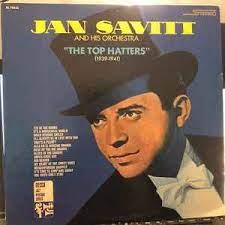
Daily Dose Of Jazz…
Jan Savitt was born Jacob Savetnick on September 4, 1907 in Shumsk, Russian Empire and reared in Philadelphia, Pennsylvania. He showed musical ability at an early age and began winning conservatory scholarships in the study of the violin. He was offered the position of concertmaster in Leopold Stokowski’s Philadelphia Symphony Orchestra, but turned it down, preferring to continue his studies at Curtis Institute. About a year later, believing himself ready, he joined Stokowski and the association continued for seven years, during which time he gained further laurels as a concert soloist and leader of a string quartet.
By 1938, Jan Savitt & His Top Hatters broadcasted as the KYW staff orchestra at KYW/NBC in Philadelphia coast-to-coast. The group also played at the Earl Theatre and performed with The Andrews Sisters and The Three Stooges.
Getting his start in popular music some time later as music director of KYW, he evolved the unique “shuffle rhythm” which remained his trademark. Numerous sustaining programs created such a demand for the “shuffle rhythm” that Jan left KYW to form his own dance crew.
His band was notable for including George “Bon Bon” Tunnell, one of the first Black singers to perform with a white band. Tunnell’s recording with Savitt included Vol Vistu Gaily Star co-composed by Slim Gaillard and Rose of the Rio Grande. Helen Englert Blaum, known at the time as Helen Warren, also sang with Savitt during the war years. His orchestra had a bit role in the 1946 film High School Hero.
Shortly before arriving in Sacramento, California with his orchestra in 1948 he was stricken with a cerebral hemorrhage and taken to Sacramento County Hospital. Bandleader, arranger, and violinist Jan Savitt, known as The Stokowski of Swing, transitioned on October 4, 1948 with his wife at his bedside.
More Posts: arranger,bandleader,history,instrumental,jazz,music,violin
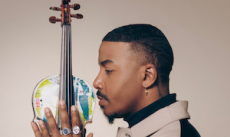
DAMIEN ESCOBAR
Damien Escobar is a world-renowned violinist, author, entrepreneur, and philanthropist, hailing from Jamaica, Queens, and New York. His musical career spans over a decade, and his inspiring journey of making it big, losing it all, fighting to rebuild, and getting a second chance at success is as much a part of his brand identity as being among the top violinist in the world.
The now NAACP Image Award nominee and Billboards chart-topping artist was once humbled by homelessness after calling it quits from his famed group, “Nuttin but Stringz.” The group, comprised of Damien and his brother, Tourie– known in NYC for playing their violins on the subway; gained global recognition when they appeared as contestants on “America’s Got Talent.” The competition helped to catapult the duo into stardom and they quickly experienced all the highs of being the most sought-after musicians of their time. However, that glory was short-lived and the fall from grace was a hard hit, to say the very least; as the group disbanded and a bruised Damien made the decision to retire his violin. What came next was a struggle– not only with his identity, and depression but with finding success in other non-creative endeavors.
Looking back at his journey, Damien realizes it all needed to fall apart so he could be forced to grow while putting it back together the right way. Prevailing was a process and it started with unburying his talent– his love of playing the violin. And in 2013 Damien released his first album as a solo artist, “Sensual Melodies.” Once thought of as a passion project, the album garnished over 200K downloads; landed on the iTunes Top 100 chart; and served as a springboard for a successful national tour where he headlined, for the first time, as the one and only, Damien Escobar.
From there, doors that were once closed, became a little easier to push open; affording Damien opportunities to tell his inspiring story to publications like People Magazine and Huffington Post; make appearances on local and national news including “The Today Show”; serve as a guest on radio broadcasts; and even accept invitations to perform at notable events such as Oprah Winfrey’s “The Life You Want” tour. Back in the spotlight, Damien decided this time around he would do more with his visibility and began his entrepreneurial walk by penning and self-publishing his very first children’s book, “The Sound of Strings”; building his very own line of custom designed violins; and establishing partnerships to develop a wine line, perfume and fragrances, and a non-profit organization that would include a music program for children.
Motivated by his past and grateful for his fans and future, Damien went on to release his second album, “Boundless.” Growing into a self-conscious artist with more than a mission to make good music, Damien sought to inspire change and spread positivity by sharing uplifting messages and telling unfiltered personal stories to sold-out arenas across the world during his second tour. Though he’s achieved more than he could have imagined after pulling himself up by his bootstraps and kick starting his solo career– Damien Escobar’s story isn’t over yet. The breakout artist has partnered with Mitsubishi and is now the face and sound of their latest campaign; he’s releasing new music and videos set to air on major broadcast channels; and, the world famous violinist, continues to build his brand centered around making an impact and inspiring social change. Stay tuned, there’s more to come.
With Special Guest Anthony Franks
Parking: $30.00 advanced purchase | $35.00 day of
Valet: $40.00 advanced purchase | $45.00 day of (if not sold out)
More Posts: adventure,festival,genius,jazz,music,preserving,travel,violin
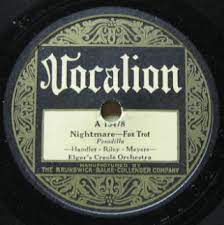
Daily Dose Of Jazz…
Charles Anthony Elgar was born on June 13, 1879 in New Orleans, Louisiana on June 13, 1879. From age 5 he played violin and also played trumpet. He studied music in Wisconsin and Illinois.
Elgar played in Chicago, Illinois from 1903 with the Bloom Theater Philharmonic Orchestra, but returned to his hometown late in the decade of the 1900s. He remained there until about 1913 when he returned to Chicago, putting together a band the same year. His band played at the Navy Pier Ballroom, Hattie Harmon’s Dreamland Ballroom from 1917 until 1922 and opened the old Savoy Ballroom in 1928.
With his band Charles toured in the revue Plantation Days and traveled to London, England though he did not accompany it on this trip. However, he did play with Will Marion Cook’s Orchestra in Europe. He went on to lead bands in Milwaukee, Wisconsin from 1925 to 1928, making several recordings with Elgars Creole Orchestra that he led at the Wisconsin Roof Gardens in Milwaukee and again in Chicago, 1926-30.
His sidemen included Manuel Perez, Lorenzo Tio, Louis Cottrell, Jr, Barney Bigard, Darnell Howard, and Omer Simeon. He made four recordings as leader of the Creole Orchestra. He concentrated on teaching in the 1930s, and worked as a union official later in his life. He was a founder and charter member of the local branch of the American Federation of Musicians, AFL-CIO, Local 2018.
Violinist, teacher and jazz bandleader Charles Elgar transitioned in August 1973 in Chicago.
More Posts: bandleader,educator,history,instrumental,jazz,music,violin
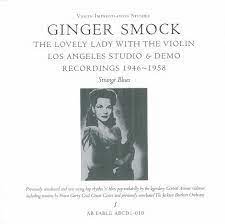
Daily Dose Of Jazz…
Ginger Smock was born Emma Smock on June 4, 1920 in Chicago, Illinois and grew up in Los Angeles, California. She graduated from Jefferson High School and studied violin privately with Bessie Dones. By the time she hit the age of 10 she appeared as a soloist at the Hollywood Bowl. She was featured on Clarence Muse’s radio program at the age of thirteen performing Edward MacDowell’s To A Wild Rose. She earned degrees in music from Los Angeles City College, and the Zoellner Conservatory of Music. At the latter institution she was a pupil of Edith Smith.
During 1944 she led a trio with Nina Russell and Mata Roy. In 1951, she led an all-female sextette, featuring Clora Bryant, on the Chicks and the Fiddle show hosted by Phil Moore that broadcasted for six weeks on CBS. The next year she was the featured soloist on KTLA’s variety show, Dixie Showboat.
1953 had Smock recording as part of a group with Gerald Wiggins, Freddie Simon, Red Callender, and Rudy Pitts, accompanying the vocalist Cecil “Count” Carter.
During the mid 1970s, she spent ten years as concertmaster of show orchestras in Las Vegas. In addition to her work in jazz and rhythm & blues, she performed with the All City Symphony Orchestra of Los Angeles. A violin owned by Smock is in the collection of the National Museum of African American History and Culture
Violinist, orchestra leader, and local Los Angeles television personality Ginger Smock, who recorded as a leader but is perhaps best known from her recordings with the Vivien Garry Quintet, transitioned on June 13, 1995.
More Posts: bandleader,concertmaster,history,instrumental,jazz,music,violin
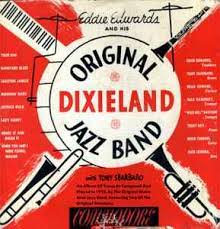
Daily Dose Of Jazz…
Edwin Branford “Eddie” Edwards was born on May 22, 1891 in New Orleans, Louisiana and started on violin at age 10 and five years later he picked up the trombone. In 1916, he was chosen to go to Chicago, Illinois by Alcide Nunez to play trombone with Johnny Stein’s Jazz Band. With a few changes of personnel, this band became the Original Dixieland Jass Band, which made the first jazz records in 1917. He played on one of the first commercially released jazz recordings, Livery Stable Blues, later released as Barnyard Blues.
Leaving the band after being drafted into the United States Army, he served from July 1918 to March 1919. After being discharged, Eddie led his own band and worked in Jimmy Durante’s band before returning to the Original Dixieland Jass Band. After that band broke up, he again led a band in New York City for most of the 1920s until retiring from music in the early Thirties. He then ran a newspaper stand and worked as a sports coach.
Coming out of retirement he returned to music in 1936 when Nick LaRocca reformed the Original Dixieland Jazz Band, playing with them until 1938. He played in other bands with Larry Shields, Tony Sbarbaro, and J. Russell Robinson in New York City into the 1940s. He continued playing professionally intermittently until shortly before his death.
His composition Sensation Rag or Sensation was performed at the 1938 Benny Goodman jazz concert at Carnegie Hall and was included on the album The Famous 1938 Carnegie Hall Jazz Concert. Darktown Strutters’ Ball, composed by Shelton Brooks, a Black man, was recorded by the Original Dixieland Jass Band and inducted into the Grammy Hall of Fame in 2006.
Trombonist Eddie Edwards, who played both violin and trombone, and who also played minor-league baseball and worked as an electrician, transitioned on April 9, 1963 in his hometown at the age of 71.
More Posts: bandleader,history,instrumental,jazz,music,trombone,violin




